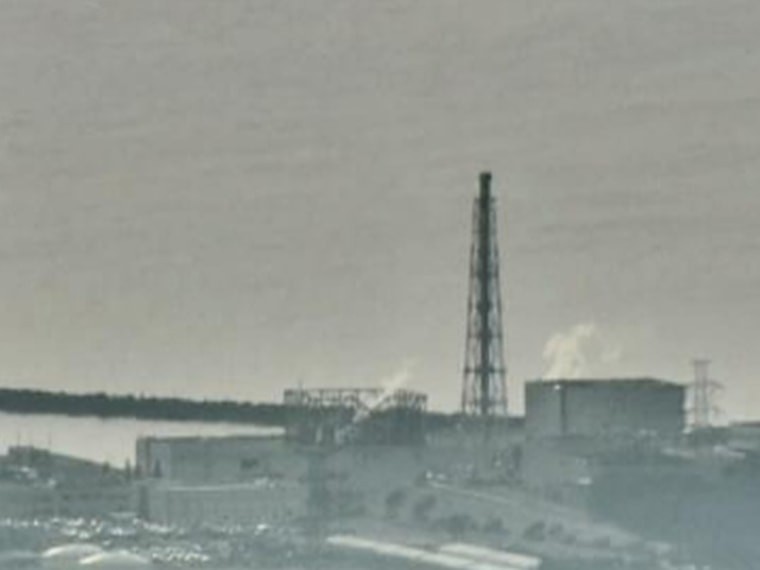
The battle to stabilize Japan's stricken Fukushima Dai-ichi nuclear complex just got tougher, due to the radioactive water that is apparently leaking from the reactors. The leak doesn’t change the battle strategy — to get water into the reactor buildings to stabilize "hot" fuel rods — but it does raise more uncertainties about how to get that done.
"The operators are having to do a lot of improvisation to figure out what best to do to keep the amount of radiation being released into the atmosphere to a minimum," nuclear engineering expert Elmer Lewis, a professor emeritus at Northwestern University, told me today.
The uncertainties currently focus on the leak, which exposed three workers wading through the water to so much radioactivity that they had to be hospitalized for radiation burns.
Some reports suggested that the skin radiation exposure amounted to 2,000 to 6,000 millisieverts. Exposure to that much full-body gamma radiation over the course of an hour would be deadly. However, in this case the burns were due to shorter-range beta radiation. The gamma radiation exposure was estimated at 170 to 180 millisieverts.
So where is that water coming from? "The data we're seeing is contradictory," said former nuclear engineer David Lochbaum, director of the Union of Concerned Scientists' nuclear safety project. It could be coming from the spent fuel rods stored near Fukushima Dai-ichi's Unit 3 reactor, or from the reactor vessel itself. The workers who came in contact with the water were working in the turbine room connected to Unit 3.
NBC News' Robert Bazell quoted outside nuclear engineers as saying that the water contained radioactive iodine-131, which could come only from the rods in the reactor's pressure vessel. That led some experts to say that the vessel was breached, but Lochbaum said that didn't mesh with the pressure readings being taken inside and outside the vessel.
"Either the pressure data we're seeing is inaccurate, or the breach isn't as serious" as some have claimed, Lochbaum told me.
If the water is leaking from the reactor vessel, it should still have been contained within the primary containment chamber that surrounds the vessel. However, there might be some sort of leak in the plumbing between the vessel and the Unit 3 turbine room. That's the scenario favored by Tom Crimmins, president at Executive & Nuclear Consulting. "There's a larger-than-expected leak somewhere in the system that's releasing this radioactive water," he said on MSNBC.
Whatever the cause, the leak is bad news for workers at the nuclear complex, "primarily because it makes working conditions there more difficult or potentially impossible," Princeton physicist Frank von Hippel said on MSNBC.
James Acton, a nuclear expert at the Carnegie Endowment for International Peace, said workers might have to pull back from the turbine rooms — not only at Unit 3, but at Units 1 and 2 as well, where elevated radiation levels have reportedly been detected. "Work in those areas is clearly going to be massively hampered, if not stopped entirely," he said, "but if radiation levels on the site as a whole don't rise, then work across the site can presumably continue."
Unit 3 is of particular concern, because that's the only reactor at the Fukushima site that uses a mixed uranium-plutonium fuel, also known as a mixed-oxide fuel or "MOX." But Lewis said some commentators are making too much of that distinction.
"Whenever you're burning uranium, you're always producing some plutonium," Lewis told me. "It's a matter of degree. The plutonium, like the uranium itself, is a ceramic element, and it's not very volatile at all. So I doubt seriously whether the water in the turbine room contains much if any plutonium. It tends not to be released except at very high temperatures. I think they're seeing fission-product radiation." (That is, radioactivity from elements such as iodine or cesium.)
Virtually all the experts are dismayed that the plant still hasn't been brought under control. "There's still too much energy coming out of that fuel to walk away," von Hippel said. "They still have to keep trying to cool it. The problem is that we're now two weeks after the accident started, and they don't have a handle on the situation yet."
The strategy remains the same as it has been for the past week: Make sure the fuel rods in the reactors as well as in the spent-fuel pools are covered with water and wait for the radioactivity in those rods to cool down.
Because Fukushima lacks electrical power to get water circulating through the reactors and the pools, workers have had to pump seawater into the works — and that could be creating a fresh round of problems, including corrosion in the plumbing and releases of radioactive steam. The prime objective right now is to get the standard water-cooling system working again.
"My own criterion for when I'll breathe easier is when they don't need seawater any more," Lewis said. So that means workers — or perhaps robots — will have to find a way to continue with the job of spraying water on the reactors, hooking up electrical power and regaining control of the nuclear battlefield.
Join the Cosmic Log community by clicking the "like" button on our Facebook page or by following msnbc.com science editor Alan Boyle as b0yle on Twitter. To learn more about Alan Boyle's book on Pluto and the search for planets, check out the website for "The Case for Pluto."